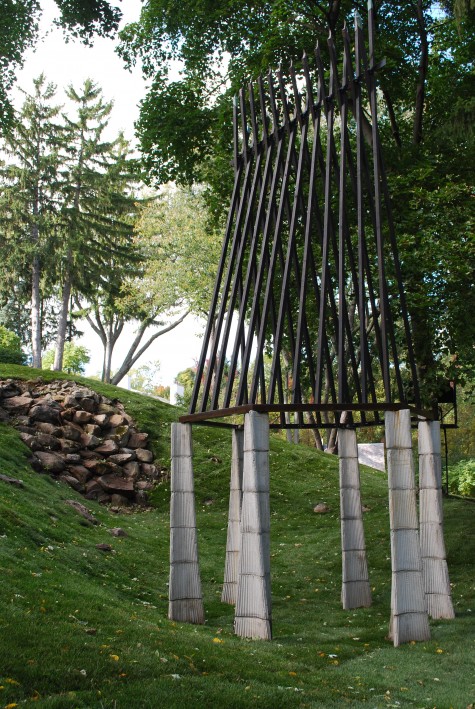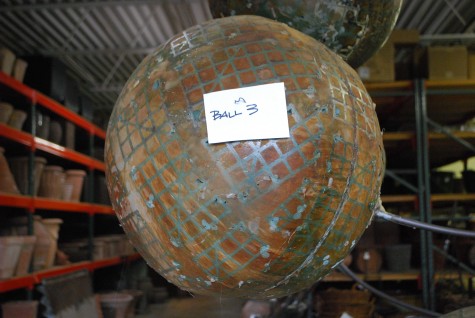 What lies behind ball number 3? I could write a novella about this client, but here is the short version. She has kept me on the edge of my design seat for better than 10 years. By this I mean she encourages me to be the best I can be. Her point of view takes unique and original to an entirely different level. She collects contemporary art, and has a fierce love for great architecture of any description. Her landscape is unlike any other that I know of, and is mostly of her own doing.
What lies behind ball number 3? I could write a novella about this client, but here is the short version. She has kept me on the edge of my design seat for better than 10 years. By this I mean she encourages me to be the best I can be. Her point of view takes unique and original to an entirely different level. She collects contemporary art, and has a fierce love for great architecture of any description. Her landscape is unlike any other that I know of, and is mostly of her own doing.
8 years ago I made this plastic grass sculpture for her. To be installed in this very fine and rare example of 19th century French iron cutwork urn lined in tin. She bought the urn from the shop-her ideas about how to plant it startled me. Would it have been my idea to plant this urn with spheres of plastic grass-no. I followed suit-this is mostly what I do with her. Had I ever made anything like this before-assuredly not. Did I like it-yes. Even on a gloomy day in January, there is a garden party going on. I am skipping over a lot of discussion between the two of us, but in the end, I believed these grass planets hovering did her particular style of justice to the urn, and the space.
 Many years this sculpture endured the sun-I had a call from her a month ago asking that I redo it. The fire had gone out of those spheres. I find even the most UV light resistant material will eventually show signs of fading. The materials available now are somewhat different than what I had to work with 8 years ago, but the interior structure and urethane spheres were intact. These spheres bob all around on a windy day; I was pleased to see that the only part of the sculpture that needed attention were the grass mats.
Many years this sculpture endured the sun-I had a call from her a month ago asking that I redo it. The fire had gone out of those spheres. I find even the most UV light resistant material will eventually show signs of fading. The materials available now are somewhat different than what I had to work with 8 years ago, but the interior structure and urethane spheres were intact. These spheres bob all around on a windy day; I was pleased to see that the only part of the sculpture that needed attention were the grass mats.
 Once the urn and sculpture were delivered to my shop, we removed all of the faded grass mats and assessed what materials we would need to recover and redo those 7 urethane spheres.
Once the urn and sculpture were delivered to my shop, we removed all of the faded grass mats and assessed what materials we would need to recover and redo those 7 urethane spheres.
 The grass mats are comprised of a plastic grid; each intersection of that grid has a tuft of grass. Given that the lime green plastic grass had the best resistance to fading, I decided to do more spheres in that color, with a variety of textures. The mats come 12 inches square, so fitting them to the curved surfaces takes a little ingenuity, and a lot of time.
The grass mats are comprised of a plastic grid; each intersection of that grid has a tuft of grass. Given that the lime green plastic grass had the best resistance to fading, I decided to do more spheres in that color, with a variety of textures. The mats come 12 inches square, so fitting them to the curved surfaces takes a little ingenuity, and a lot of time.
 We removed the grass tufts, and fitted the grids in much the same pattern as the original. Even on the largest sphere, no 12″ by 12″ grid would lay flat. We had to cut the grids just small enough to enable a smooth surface. Once the grid pieces had their tufts reattached, we filled in any areas that seemed thin with grid pieces 12″ long, and one tuft wide. Each piece of grid is secured to the surface of the sphere with greening pins. A lot of this work had to be done on a ladder; the overall height of the piece is about 7 feet.
We removed the grass tufts, and fitted the grids in much the same pattern as the original. Even on the largest sphere, no 12″ by 12″ grid would lay flat. We had to cut the grids just small enough to enable a smooth surface. Once the grid pieces had their tufts reattached, we filled in any areas that seemed thin with grid pieces 12″ long, and one tuft wide. Each piece of grid is secured to the surface of the sphere with greening pins. A lot of this work had to be done on a ladder; the overall height of the piece is about 7 feet.
 This chartreuse plastic grass has vibrant color, and great texture. Neither the urethane balls nor the grass mats absorb water. Both rain and snow keep it clean.
This chartreuse plastic grass has vibrant color, and great texture. Neither the urethane balls nor the grass mats absorb water. Both rain and snow keep it clean.
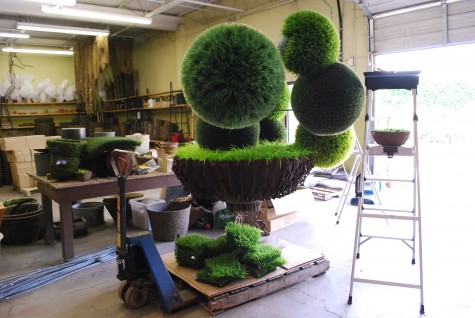 A new life for this sculpture-we finished it today. I like a working life that has lots of variety, and in this case, a little off beat. Does it bother me-the plastic part? Not at all. No matter the material, the sculpture is the result of the work of a group of real people.
A new life for this sculpture-we finished it today. I like a working life that has lots of variety, and in this case, a little off beat. Does it bother me-the plastic part? Not at all. No matter the material, the sculpture is the result of the work of a group of real people.
 We loaded up the sculpture this morning. A large diameter steel ring fastened to the interior of the urn keeps the sculpture upright. This was an important part of the construction, as the finished piece is extremely heavy. This also meant we were able to move the entire piece with relative ease.
We loaded up the sculpture this morning. A large diameter steel ring fastened to the interior of the urn keeps the sculpture upright. This was an important part of the construction, as the finished piece is extremely heavy. This also meant we were able to move the entire piece with relative ease.
The sculpture is back in place, doing its provocative best to tell another kind of story.


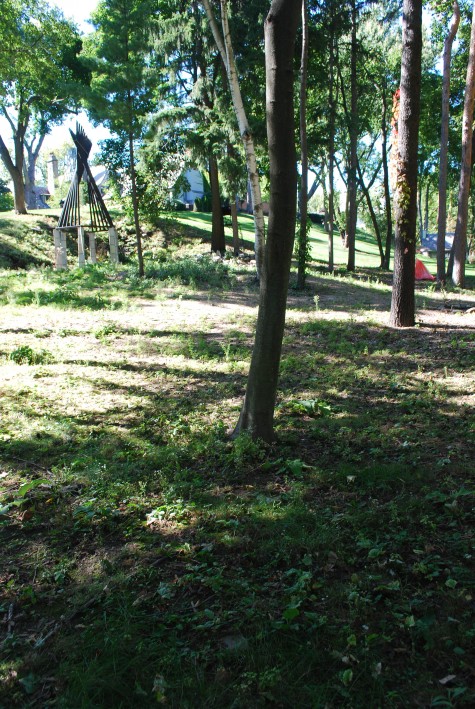 For years my client and I had been looking at a certain giant blob of a thicket on her property. Lanky buckthorn, lilac and other unkempt and untended shrubs had made the space impenetrable. The fact that the area was on a steep slope made investigating what was there all the more difficult.Not knowing what was in there made it easy to just mow around it, and act like it was part of a landscape. Every so often she would talk about what might be in there; this went on for some years.
For years my client and I had been looking at a certain giant blob of a thicket on her property. Lanky buckthorn, lilac and other unkempt and untended shrubs had made the space impenetrable. The fact that the area was on a steep slope made investigating what was there all the more difficult.Not knowing what was in there made it easy to just mow around it, and act like it was part of a landscape. Every so often she would talk about what might be in there; this went on for some years.  One day she called to say she had clear cut the entire spot, and discovered an old rock waterfall and pool. No doubt it dated back to the 1920’s. The precipitous drop, lined with giant rocks, was entirely stable. There was a lot of discussion about restoring the watefall and pool, which led to some discussion of a new fountain; more years went by. One day she called to say she wanted me to look at the space again-I thought as the thicket was threatening to grow back-we were being chased for a plan. How like her to install an enormous concrete and wood sculpture in the center of the old pool. This is so distinctively her way of working things out. Making a move like that was forcing everyone’s hand. I told her I thought a sculpture of this size and proportion needed its own park.
One day she called to say she had clear cut the entire spot, and discovered an old rock waterfall and pool. No doubt it dated back to the 1920’s. The precipitous drop, lined with giant rocks, was entirely stable. There was a lot of discussion about restoring the watefall and pool, which led to some discussion of a new fountain; more years went by. One day she called to say she wanted me to look at the space again-I thought as the thicket was threatening to grow back-we were being chased for a plan. How like her to install an enormous concrete and wood sculpture in the center of the old pool. This is so distinctively her way of working things out. Making a move like that was forcing everyone’s hand. I told her I thought a sculpture of this size and proportion needed its own park.  The sculptor had sunk concrete pilings in giant sonatubes. Still visible in the above picture, it was apparent no small amount of grading was needed. My client was concerned that the pool would hold water. The rim of outside soil needed to be taken down. A giant pile of rocks collected from the first clear cutting went into the hole first. Trapping water near the sculpture would not be a good idea.
The sculptor had sunk concrete pilings in giant sonatubes. Still visible in the above picture, it was apparent no small amount of grading was needed. My client was concerned that the pool would hold water. The rim of outside soil needed to be taken down. A giant pile of rocks collected from the first clear cutting went into the hole first. Trapping water near the sculpture would not be a good idea. A skid steer made quick work of removing the weedy growth that had begun to take hold. I have watched the history channel television series called “Life After People” with great interest. It is astonishing how little time it takes for untended ground to go to rack and ruin. Nature abhors a vacuum; any bare dirt will have something going on in short order. Ignore a space, and nature will take over in your absence.
A skid steer made quick work of removing the weedy growth that had begun to take hold. I have watched the history channel television series called “Life After People” with great interest. It is astonishing how little time it takes for untended ground to go to rack and ruin. Nature abhors a vacuum; any bare dirt will have something going on in short order. Ignore a space, and nature will take over in your absence.  The front edge of the old pool was lowered to permit water to escape. I so love this point in a landscape project; bare sculpted dirt is incredibly beautiful. A landscape of evergreens planted in sculpted, cultivated soil-a landscape of my dreams. Barked areas in a garden leave me cold-I like to cover the ground with plants, or see dirt. I mulch strictly to conserve moisture in the soil. The pattern of light and dark on the ground here is telling. The old waterfall and pool were situated in a patch of sun. The sculpture benefits from this.
The front edge of the old pool was lowered to permit water to escape. I so love this point in a landscape project; bare sculpted dirt is incredibly beautiful. A landscape of evergreens planted in sculpted, cultivated soil-a landscape of my dreams. Barked areas in a garden leave me cold-I like to cover the ground with plants, or see dirt. I mulch strictly to conserve moisture in the soil. The pattern of light and dark on the ground here is telling. The old waterfall and pool were situated in a patch of sun. The sculpture benefits from this.  New lawn softens all the hard edges. The rolling, swelling and dipping of the ground makes for a big fluid situation for the starkly vertical sculpture on its big legs. They look good together.
New lawn softens all the hard edges. The rolling, swelling and dipping of the ground makes for a big fluid situation for the starkly vertical sculpture on its big legs. They look good together. 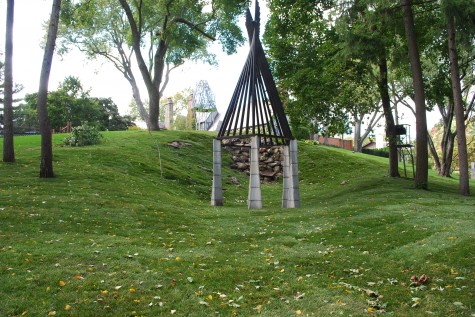 The fountain rockwork we left exposed. It is a part of the history of the property. Practically speaking, I would never have removed those giant stones; they have stabilized soil existing at a very steep angle. In the spring, my client will be able to pick and choose what she mows, and what she chooses to let be. There is a sculptural element yet to come-the decision about how and where to cut the lawn.
The fountain rockwork we left exposed. It is a part of the history of the property. Practically speaking, I would never have removed those giant stones; they have stabilized soil existing at a very steep angle. In the spring, my client will be able to pick and choose what she mows, and what she chooses to let be. There is a sculptural element yet to come-the decision about how and where to cut the lawn.